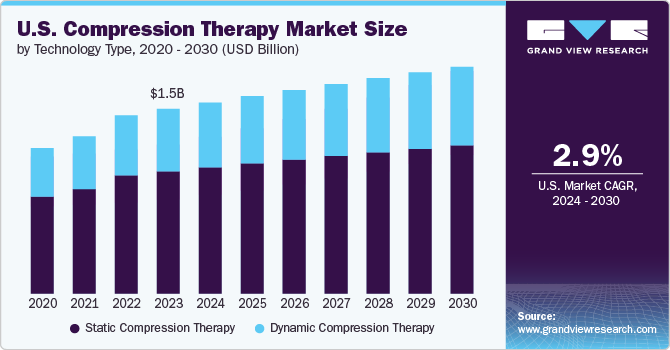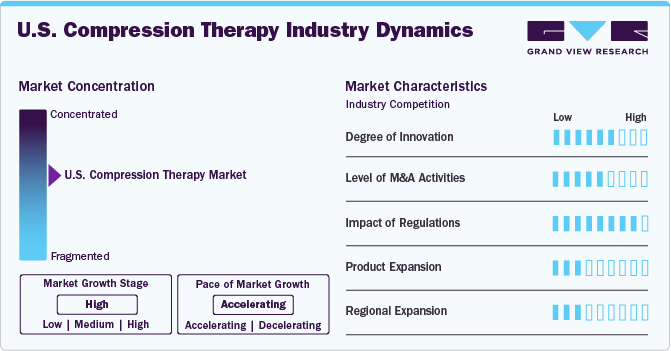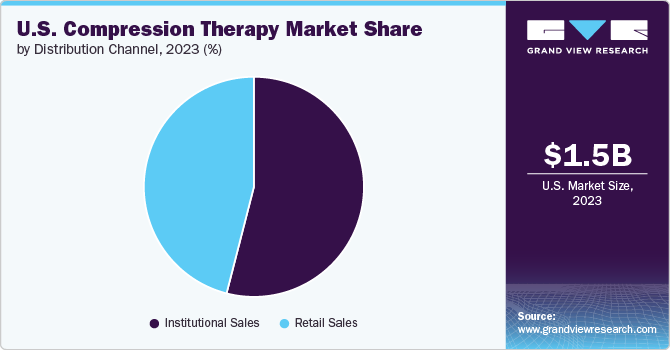
U.S. Compression Therapy Market Size, Share & Trends Analysis Report By Technology (Static Compression Therapy, Dynamic Compression Therapy), By Distribution Channel (Institutional Sales, Retail Sales), By End Use, By Region And Segment Forecasts, 2024 - 2030
- Report ID: GVR-4-68040-426-3
- Number of Report Pages: 111
- Format: PDF, Horizon Databook
- Historical Range: 2018 - 2023
- Forecast Period: 2024 - 2030
- Industry: Healthcare
U.S. Compression Therapy Market Trends
The U.S. compression therapy market size was estimated at USD 1.52 billion in 2023 and is projected to grow at a CAGR of 2.90% from 2024 to 2030. Growing awareness about venous disorders such as chronic venous insufficiency (CVI) and deep vein thrombosis (DVT) is driving demand for compression therapy products. Educational campaigns and health initiatives are highlighting the benefits of compression therapy in managing these conditions. The increasing prevalence of chronic conditions such as diabetes, obesity, and hypertension are contributing to a higher incidence of venous and lymphatic disorders, which in turn drives the demand for compression therapy. According to the CDC, 38.4 million people of all ages, or 11.6% of the U.S. population, had diabetes.

The rise in the number of orthopedic procedures is another factor causing an increased demand for compression therapy as a component of postoperative care and rehabilitation protocols. The major factors causing a rise in these procedures are attributed to increased geriatric population, sport-related injuries, and advancements in surgical techniques giving rise to orthopedic surgeries, such as joint replacements (knee or hip replacements), fracture repairs, ligament reconstruction and arthroscopic surgeries. For instance, the American College of Rheumatology updated February 2024, recorded about 790,000 knee replacement surgeries and 544,000 hip replacement procedures being conducted annually, and the number continues to increase owing to the rise in geriatric population.
As the world's population ages, there is a subsequent increase in the demand for healthcare services and infrastructure to address the unique & evolving healthcare needs of older adults. The U.S. has a rapidly growing elderly population, which is associated with increased healthcare spending. According to America's Health Rankings 2022 data, approximately 58 million adults aged 65 and above currently reside in the U.S., constituting around 17.3% of the nation's population. Projections indicate that by 2040, this proportion is anticipated to grow to 22%. This demographic is more prone to circulatory issues, varicose veins, and edema, all of which are treated with compression therapy. As a result, the demand for compression products is rising, fueled by healthcare spending on geriatric care.
Healthcare spending in the U.S. is directed toward managing chronic conditions such as venous disorders, diabetes, and lymphedema, which are prevalent among the aging population. According to CMS data, by July 2024, U.S. healthcare spending grew by 4.1% in 2022, reaching USD 4.5 trillion or USD 13,493 per person. Compression therapy is a standard treatment for these conditions, leading to increased demand for compression garments, stockings, and bandages. With rising healthcare costs, there is a growing emphasis on preventive care to manage chronic conditions early. Compression therapy is recommended as a preventive measure for conditions like deep vein thrombosis (DVT), driving market growth.
Market Characteristics & Concentration
The market growth stage is medium, and the pace of the market growth is accelerating. The market is characterized by increasing cases of chronic diseases, a rising geriatric population coupled with increasing novel product launches.
The market is characterized by a high degree of innovation, driven by advancements in materials, technology integration, patient-centric design, and personalized treatment solutions. These innovations are transforming compression therapy from traditional, static garments into dynamic, effective, and user-friendly medical solutions. Advanced compression therapy devices are beginning to incorporate data analytics and artificial intelligence (AI) to optimize treatment. AI can analyze data from wearable devices to predict outcomes, customize treatment plans, and alert healthcare providers to potential issues.

In the U.S., compression therapy products, such as compression stockings, sleeves, and bandages, are classified as medical devices by the Food and Drug Administration (FDA). Depending on their intended use, these products can be categorized under Class I, II, or III devices, with varying levels of regulatory scrutiny. For example, Class I devices typically have lower risk and are subject to general controls. In contrast, Class II devices may require additional regulatory requirements, such as premarket notification (510(k)), to demonstrate substantial equivalence to an existing device.
The market has seen a notable level of mergers and acquisitions (M&A) activity in recent years. This trend is driven by several factors, including the growing demand for compression therapy products, the need for companies to expand their product portfolios, and the desire to enhance market presence and technological capabilities. For instance, in November 2021, Essity acquired Johnson & Johnson Consumer Inc.’s professional sports tape brands Coach and Zonas. These premium products hold a strong presence in the U.S. market.
The market has witnessed several significant product launches in recent years, reflecting ongoing innovation and the growing demand for effective solutions to manage conditions such as venous disorders, lymphedema, and post-surgical recovery. These product launches focus on enhancing patient comfort, improving therapeutic outcomes, and integrating advanced technologies.
The market has experienced significant regional expansion as companies seek to tap into varying demand across different states and regions. This expansion is driven by factors such as demographic differences, healthcare infrastructure, regional prevalence of chronic conditions, and the availability of healthcare services.
Technology Insights
Based on technology, the static technology segment dominated the market within 2023. The segment has witnessed considerable growth due to the high convenience and user-friendly qualities of this technology. The sizable share acquired by this segment can be attributed to the increased accessibility of these products in treating edema and sports-related injuries to enable pain & pressure relief. Furthermore, patients and physicians are inclined toward static technology due to its advantages, accounting for its dominant share.
Furthermore, the introduction of new products in the static compression therapy segment has significantly boosted the market. Static compression therapy, which includes products like compression stockings, bandages, and garments, is essential for managing various medical conditions such as chronic venous insufficiency, lymphedema, and post-surgical recovery.
For instance, in October 2023, Medi GmbH & Co. launched the Medi Rehab one compression stocking, which is available in thigh stocking and calf stocking versions with either an open or closed toe. Particularly in the conservative or postoperative treatment of ankle joint injuries or Achilles tendon ruptures, the calf stocking with an open toe makes it particularly easy and comfortable to put on and take off.
Dynamic compression therapy technology is emerging as one of the fastest-growing segments in the market. This technology offers enhanced therapeutic benefits for various conditions. Dynamic compression therapy is known for its ability to improve blood flow, reduce edema, and accelerate the healing process, particularly for conditions such as deep vein thrombosis (DVT), lymphedema, and chronic venous insufficiency. The ability to provide more effective treatment compared to static compression is driving its adoption in clinical and home settings.
End Use Type Insights
The hospital End Use segment dominated the market in 2023 with a share of 31.05%. Compression therapy is integrated into hospital protocols for managing conditions such as venous disorders, wound care, and post-surgical recovery. The use of compression garments, bandages, and devices is often mandated as part of treatment guidelines, ensuring consistent demand within hospitals. In many hospitals, compression stockings or pneumatic compression devices are automatically prescribed for bedridden or limited mobility patients to prevent DVT, making these products a staple in hospital care.
The home healthcare segment is anticipated to grow significantly over the forecast period. Innovations in compression therapy devices designed specifically for home use, such as portable pneumatic compression pumps and easy-to-use compression garments, are driving growth in this segment. These products are designed to be user-friendly and require minimal assistance. Patients increasingly prefer receiving care in the comfort of their own homes rather than in clinical settings. Home-based compression therapy allows for greater convenience and personal comfort, leading to higher patient satisfaction and adherence.
Distribution Channel Insights
The institutional sales segment dominated the market in 2023. Due to their high patient volume, institutions such as hospitals and large clinics procure compression therapy products in bulk, which drives significant sales through institutional channels. Compression therapy is integrated into standard treatment protocols for various conditions, including venous disorders, lymphedema, and post-surgical recovery.
This integration ensures that these products are regularly used and purchased through institutional channels. Institutions have the resources to invest in advanced compression therapy technologies, such as high-end pneumatic compression devices and specialized compression garments. These technologies are more complex and expensive, making them more commonly purchased through institutional channels.

The retail sales distribution channel is anticipated to grow at the fastest CAGR in the market. There is a rising awareness among consumers about the benefits of compression therapy for managing conditions such as varicose veins, chronic venous insufficiency, and lymphedema. This heightened awareness drives increased consumer interest and demand for compression products available through retail channels. The growth of e-commerce has made it easier for consumers to access compression therapy products from the comfort of their homes.
Online retailers offer a wide range of compression products, including stockings, sleeves, and bandages, with convenient delivery options. Retail channels, including pharmacies, medical supply stores, and specialty retailers, have expanded their product offerings to include compression therapy items. This increased availability makes it easier for consumers to purchase these products without needing a prescription or visiting a healthcare facility.
Key U.S. Compression Therapy Company Insights
The key players operating in the U.S. market are adopting product approval to increase the reach of their products in the market and improve the availability of their products in diverse geographical areas, along with expansion as a strategy to enhance production/research activities. In addition, several market players are acquiring smaller players to strengthen their market position. This strategy enables companies to increase their capabilities, expand their product portfolios, and improve their competencies.
Key U.S. Compression Therapy Companies:
- Cardinal Health
- 3M
- SIGVARIS GROUP
- Essity
- Julius Zorn, Inc.
- HARTMANN USA, Inc
- Bauerfeind USA Inc.
- medi USA
- BIOCOMPRESSION SYSTEMS
- Gottfried Medical, Inc.
Recent Developments
-
In October 2023, medi USA launched, round-knit medical compression stocking mediven cotton for vein therapy as a custom-made supply.
-
In October 20232,3M and MediWound announced its strategic partnership for EscharEx’s Phase III Clinical Trial, strengthening their alliance in the medical industry.
-
In September 2023, Tactile Medical received a patent for a new compression garment system. This system uses adjustable pressure to move fluids within the body towards specialized cells that help manage those fluids.
-
In March 2022, Cardinal Health unveiled its intentions to construct a 574,670-square-foot medical distribution facility in the Columbus, Ohio, region.
U.S. Compression Therapy Market Report Scope
|
Report Attribute |
Details |
|
Market size value in 2024 |
USD 1.57 billion |
|
Revenue forecast in 2030 |
USD 1.87 billion |
|
Growth rate |
CAGR of 2.90% from 2024 to 2030 |
|
Actual data |
2018 - 2023 |
|
Forecast period |
2024 - 2030 |
|
Quantitative units |
Revenue in USD million and CAGR from 2024 to 2030 |
|
Report coverage |
Revenue forecast, company ranking, competitive landscape, growth factors, trends, and volume analysis |
|
Segments covered |
Technology, end use, distribution channel |
|
Regional scope |
U.S. |
|
Key companies profiled |
Cardinal Health; 3M; SIGVARIS GROUP; Essity ; Julius Zorn, Inc.; HARTMANN USA, Inc; Bauerfeind USA Inc.; medi USA; BIOCOMPRESSION SYSTEMS; Gottfried Medical, Inc. |
|
Customization scope |
Free report customization (equivalent up to 8 analysts working days) with purchase. Addition or alteration to country, & segment scope. |
|
Pricing and purchase options |
Avail customized purchase options to meet your exact research needs. Explore purchase options |
U.S. Compression Therapy Market Report Segmentation
This report forecasts revenue growth and provides an analysis of the latest industry trends in each of the sub-segments from 2018 to 2030. For this study, Grand View Research has segmented the U.S. compression therapy market report based on technology, End Use, and distribution channel:
-
Technology Outlook (Revenue, USD Million; 2018 - 2030)
-
Static Compression Therapy
-
Compression bandages
-
Compression stockings
-
Compression tape
-
Others compression garments
-
-
Dynamic Compression Therapy
-
Compression Pumps
-
Compression Sleeves
-
-
-
End Use Outlook (Revenue, USD Million; 2018 - 2030)
-
Hospitals
-
Specialty Clinics
-
Home healthcare
-
Physician’s Office
-
Nursing Homes
-
Others
-
-
Distribution Channel Outlook (Revenue, USD Million; 2018 - 2030)
-
Institutional Sales
-
Retail Sales
-
Frequently Asked Questions About This Report
b. The U.S. compression therapy market size was estimated at USD 1.52 billion in 2023 and is expected to reach USD 1.87 billion in 2030.
b. The U.S. compression therapy market is expected to grow at a compound annual growth rate of 2.90% from 2024 to 20230 to reach USD 1.87 billion by 2030.
b. Static compression therapy dominated the U.S. compression therapy market. This is attributable to established clinical effectiveness, wide range of product offerings, ease of use, cost-effectiveness, strong clinical and regulatory support, and high demand driven by chronic conditions.
b. Cardinal Health, 3M, SIGVARIS GROUP, Essity, Julius Zorn, Inc., HARTMANN USA, Inc, Bauerfeind USA Inc., medi USA, BIOCOMPRESSION SYSTEMS, Gottfried Medical, Inc.
b. The increasing incidence of chronic venous disorders, such as chronic venous insufficiency (CVI), deep vein thrombosis (DVT), and varicose veins, drives demand for compression therapy.
We are committed towards customer satisfaction, and quality service.
"The quality of research they have done for us has been excellent."




